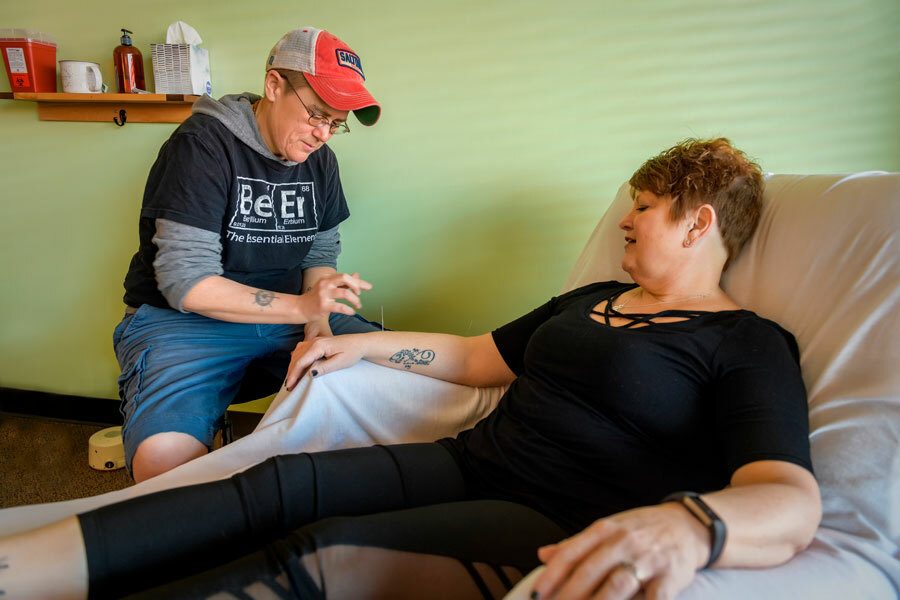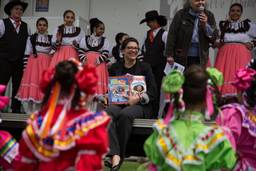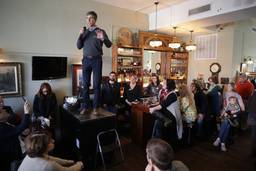The Cooperative Acupuncture Clinics Popping Up in Middle America
With skyrocketing healthcare costs, residents of Middle America are turning to acupuncture.
Valerie Vande Panne

In a nondescript strip mall that could be just about anywhere in America, Cait Cain has set up nine secondhand recliners. White noise plays soothingly as a few women lie back, receiving acupuncture.
What they probably don’t realize is that they are taking part in one of the quietest revolutions growing across the country: cooperative community acupuncture.
Acupuncture has been used for millennia, and studies show it is effective in alleviating chronic pain from a wide range of ailments, including joint pain, migraines, opioid addiction and menopause-related symptoms. It was once considered a boutique option in the United States but is now becoming more accessible thanks to the community acupuncture model championed by Cain and others. Multiple people are treated in a group environment for a sliding-scale fee that can be as low as $10 per session.
The cost is enticing for people with otherwise high medical bills. As healthcare costs have steadily risen, over half of insured Americans struggle to pay their medical bills. According to Adam Gaffney, president of Physicians for a National Health Program and an instructor at Harvard Medical School, the “financial barriers” created by the current U.S. healthcare system may lead some to “seek out unorthodox care because it’s more affordable.”
The unorthodox care of acupuncture is becoming increasingly available thanks to the cooperative, people-first model. Cain opened Lincoln Acupuncture Project (LAP) in March 2018 with the help of a micro-loan from the People’s Organization of Community Acupuncture (POCA), a cooperative formed in 2011 by clinics, practitioners and patients. Today there are more than 150 member clinics, with a growing presence in Middle America. (The author is an individual POCA member and has attended POCA clinics for the past 10 years.) Cain explains that acupuncture doesn’t replace other medical procedures, but it can be used alongside conventional medical treatment. Her patients include people being treated for MS, Parkinson’s, cancer and other ailments.
Amy Wiebe-Ewoldt, 55, lives in the small town of Mullen, Neb. She drives nearly 300 miles to Cain’s clinic to receive acupuncture, which has eased both her anxiety and jaw pain, she says, for an out-of-pocket cost of between $15 and $35 per treatment. Marla McCabe, 88, has seen Cain twice a week for a couple of months and views acupuncture as “health maintenance.” McCabe goes to her regular doctor for a physical once a year and whenever serious medical issues come up, but she’s frustrated with how long it takes to get an appointment. “Sometimes it can take two to three weeks, maybe four,” she says. With LAP, you don’t need an appointment. “Cain has certain hours, and you go when she’s there. It’s just so easy. And she’s competent.”
The low sliding-scale cost of community acupuncture sessions is intended to make treatment more accessible for patients who struggle to pay their medical bills. “If you want a system according to needs and not means, you need a system of universal coverage and no copays or deductibles,” says Gaffney. As Congress turned away from universal healthcare and embraced a hybrid, market-based approach, the “interests of corporate America took precedence over interest of patients,” he says. “Money gets siphoned off into private shareholders’ and executives’ pockets,” so patients end up paying the price, out of their own pockets and with their own health.
But cost is not the only barrier to healthcare. Patients also face challenges navigating a labyrinth of networks and restrictive coverage parameters. For Matthew Smith, 39, seeing Cain for acupuncture is easier than fighting with his medical insurance provider to cover treatment for his tendonitis and other health issues. When Smith’s insurance company insisted he pay for an MRI out-of-pocket, he spent hours on the phone with them. This went on for months, until the insurance company agreed to pay.
Smith says the process of working with his insurance company, getting claims paid and also recovering from the physical toll of surgery was “torture” compared with the straightforward process of seeing Cain for acupuncture. After his initial meeting with Cain, he knew exactly what to expect in terms of payment. “Even the paperwork is more gentle,” he says.
Not all patients have the time, education or tenacity to demand a medical insurance company pay for the care they need. Part of community acupuncture’s success is that it is often easier to access than traditional medical treatment, says Jade Fang, 36, owner of Jade Community Acupuncture Clinic in Winona, Minn. “If you have a migraine, I’m not gonna make you wait a month to get treatment,” she says.
Lisa Rohleder, a licensed acupuncturist in Portland, Ore., and co-founder of POCA, has seen the effects that for-profit medical care and insurance have had on her patients: “You see people get acupuncture because they can’t afford their inhalers. Then you see people who’ve had medical care, but clearly they weren’t helped.”
Rohleder is taking action to help underserved communities by creating more clinics in rural America. Acupuncturists typically come out of school about $100,000 in debt, she explains. That debt makes it hard to open a community clinic, so Rohleder helped launch POCA Tech, a community acupuncture school with a tuition of less than $6,000. The first class graduated in 2017, with a commitment to open community clinics in underserved areas, including tentative plans for clinics in both Kansas and Montana.
“The need is gigantic,” Cain says.








